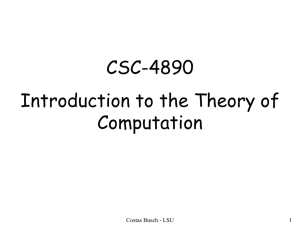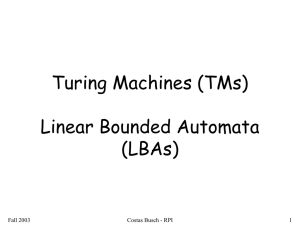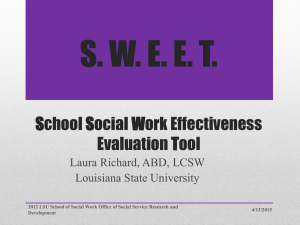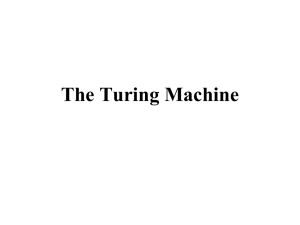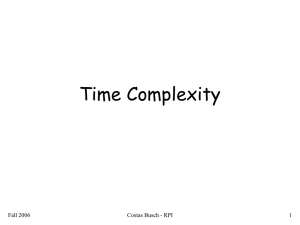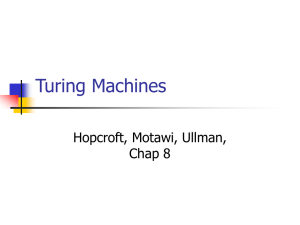Variations of Turing Machines
advertisement
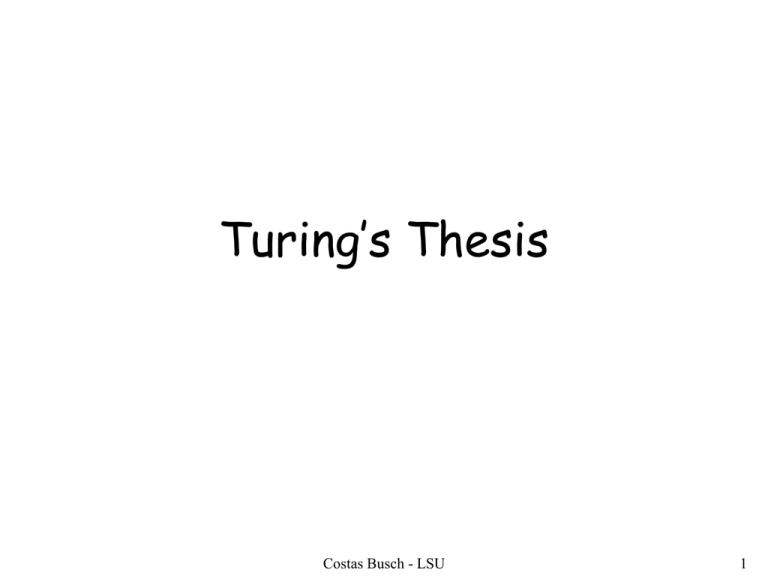
Turing’s Thesis
Costas Busch - LSU
1
Turing’s thesis (1930):
Any computation carried out
by mechanical means
can be performed by a Turing Machine
Costas Busch - LSU
2
Algorithm:
An algorithm for a problem is a
Turing Machine which solves the problem
The algorithm describes the steps of
the mechanical means
This is easily translated to computation steps
of a Turing machine
Costas Busch - LSU
3
When we say: There exists an algorithm
We mean: There exists a Turing Machine
that executes the algorithm
Costas Busch - LSU
4
Variations
of the
Turing Machine
Costas Busch - LSU
5
The Standard Model
Infinite Tape
aababb cac a
Read-Write Head
(Left or Right)
Control Unit
Deterministic
Costas Busch - LSU
6
Variations of the Standard Model
Turing machines with: • Stay-Option
• Semi-Infinite Tape
• Multitape
• Multidimensional
• Nondeterministic
Different Turing Machine Classes
Costas Busch - LSU
7
Same Power of two machine classes:
both classes accept the
same set of languages
We will prove:
each new class has the same power
with Standard Turing Machine
(accept Turing-Recognizable Languages)
Costas Busch - LSU
8
Same Power of two classes means:
for any machine
M1
there is a machine
such that:
of first class
M2
of second class
L( M1) L( M 2 )
and vice-versa
Costas Busch - LSU
9
Simulation: A technique to prove same power.
Simulate the machine of one class
with a machine of the other class
First Class
Original Machine
Second Class
Simulation Machine
M2
M1
M1
simulates
Costas Busch - LSU
M1
10
Configurations in the Original Machine
have corresponding configurations
in the Simulation Machine M 2
Original Machine:
Simulation Machine:
M1
M1
d0 d1 d n
d 0 d1 d n
M2
Costas Busch - LSU
11
Accepting Configuration
Original Machine:
df
Simulation Machine:
d f
the Simulation Machine
and the Original Machine
accept the same strings
L( M1) L( M 2 )
Costas Busch - LSU
12
Turing Machines with Stay-Option
The head can stay in the same position
aababb cac a
Left, Right, Stay
L,R,S: possible head moves
Costas Busch - LSU
13
Example:
Time 1
aababb cac a
q1
Time 2
b ab ab b c ac a
q2
q1
a b, S
Costas Busch - LSU
q2
14
Theorem: Stay-Option machines
have the same power with
Standard Turing machines
Proof: 1. Stay-Option Machines
simulate Standard Turing machines
2. Standard Turing machines
simulate Stay-Option machines
Costas Busch - LSU
15
1. Stay-Option Machines
simulate Standard Turing machines
Trivial: any standard Turing machine
is also a Stay-Option machine
Costas Busch - LSU
16
2. Standard Turing machines
simulate Stay-Option machines
We need to simulate the stay head option
with two head moves, one left and one right
Costas Busch - LSU
17
Stay-Option Machine
q1
a b, S
q2
Simulation in Standard Machine
q1
a b, L
x x, R
q2
For every possible tape symbol
Costas Busch - LSU
x
18
For other transitions nothing changes
Stay-Option Machine
q1
a b, L
q2
Simulation in Standard Machine
q1
a b, L
q2
Similar for Right moves
Costas Busch - LSU
19
example of simulation
Stay-Option Machine:
q1 a b, S q2
1
aaba
baba
2
q1
q2
Simulation in Standard Machine:
1
aaba
q1
2
baba
q2
3
baba
q3
END OF PROOF
Costas Busch - LSU
20
A useful trick: Multiple Track Tape
helps for more complicated simulations
One Tape
a b a b
b a c d
track 1
track 2
One head
One symbol ( a, b)
It is a standard Turing machine, but each tape alphabet symbol
describes a pair of actual useful symbols
Costas Busch - LSU
21
track 1
a b a b
b a c d
track 2
q1
track 1
a c a b
b d c d
track 2
q2
q1
(b, a) (c, d ), L
Costas Busch - LSU
q2
22
Semi-Infinite Tape
The head extends infinitely only to the right
a b a c
.........
• Initial position is the leftmost cell
• When the head moves left from the border,
it returns back to leftmost position
Costas Busch - LSU
23
Theorem:
Semi-Infinite machines
have the same power with
Standard Turing machines
Proof: 1. Standard Turing machines
simulate Semi-Infinite machines
2. Semi-Infinite Machines
simulate Standard Turing machines
Costas Busch - LSU
24
1. Standard Turing machines simulate
Semi-Infinite machines:
.........
# a b a c
.........
Standard Turing Machine
Semi-Infinite machine modifications
a. insert special symbol
#
at left of input string
b. Add a self-loop
to every state
## , R
(except states with no
outgoing transitions)
Costas Busch - LSU
25
2. Semi-Infinite tape machines simulate
Standard Turing machines:
.........
Standard machine
.........
Semi-Infinite tape machine
.........
Squeeze infinity of both directions
to one direction
Costas Busch - LSU
26
.........
Standard machine
a b c d e .........
reference point
Semi-Infinite tape machine with two tracks
Right part # d e
Left part
# c b a
Costas Busch - LSU
.........
27
Standard machine
q1
q2
Semi-Infinite tape machine
Left part
L
q1
Right part
L
q2
R
q1
Costas Busch - LSU
R
q2
28
Standard machine
q1
a g, R
q2
Semi-Infinite tape machine
Right part
R
q1
Left part
L
q1
(a, x) ( g , x), R
( x, a) ( x, g ), L
For all tape symbols
Costas Busch - LSU
x
R
q2
L
q2
29
Time 1
Standard machine
.........
.........
a b c d e
q1
Semi-Infinite tape machine
Right part # d e
Left part
# c b a
L
q1
Costas Busch - LSU
.........
30
Time 2
Standard machine
.........
.........
g b c d e
q2
Semi-Infinite tape machine
Right part # d e
Left part
# c b g
L
q2
Costas Busch - LSU
.........
31
At the border:
Semi-Infinite tape machine
Right part
R
q1
Left part
L
q1
(# , # ) (# , # ), R
(# , # ) (# , # ), R
Costas Busch - LSU
L
q1
R
q1
32
Semi-Infinite tape machine
Time 1
Right part # d e
Left part
# c b g
.........
L
q1
Time 2
Right part # d e
Left part
# c b g
R
q1
.........
END OF PROOF
Costas Busch - LSU
33
Multi-tape Turing Machines
Control unit
(state machine)
Tape 1
Tape 2
g
f
e
a b c
Input string
Input string appears on Tape 1
Costas Busch - LSU
34
Tape 1
Time 1
Tape 2
a b c
g
f
e
q1
q1
Tape 1
Time 2
Tape 2
g
e
d
a g c
q2
q2
q1
(b, f ) ( g , d ), L, R
Costas Busch - LSU
q2
35
Theorem: Multi-tape machines
have the same power with
Standard Turing machines
Proof: 1. Multi-tape machines
simulate Standard Turing machines
2. Standard Turing machines
simulate Multi-tape machines
Costas Busch - LSU
36
1. Multi-tape machines simulate
Standard Turing Machines:
Trivial: Use one tape
Costas Busch - LSU
37
2. Standard Turing machines simulate
Multi-tape machines:
Standard machine:
• Uses a multi-track tape to simulate
the multiple tapes
• A tape of the Multi-tape machine
corresponds to a pair of tracks
Costas Busch - LSU
38
Multi-tape Machine
Tape 1
Tape 2
g
f
e
h
a b c
Standard machine with four track tape
a
0
e
0
b
1
f
0
c
0
g h
1 0
Costas Busch - LSU
Tape 1
head position
Tape 2
head position
39
Reference point
#
#
#
#
a
0
e
0
b
1
f
0
c
0
g h
1 0
Tape 1
head position
Tape 2
head position
Repeat for each Multi-tape state transition:
1.
2.
3.
4.
Return to reference point
Find current symbol in Track 1 and update
Return to reference point
Find current symbol in Tape 2 and update
Costas Busch - LSU
END OF PROOF
40
Same power doesn’t imply same speed:
n n
L {a b }
2
Standard Turing machine: O ( n ) time
2
O
(
n
) times
Go back and forth
to match the a’s with the b’s
2-tape machine: O(n) time
n
1. Copy b to tape 2
(O(n) steps)
n
2. Compare a on tape 1
and
n
b tape 2
Costas Busch - LSU
(O(n) steps)
41
Multidimensional Turing Machines
2-dimensional tape
y
c a
b
MOVES: L,R,U,D
U: up D: down
x
HEAD
Position: +2, -1
Costas Busch - LSU
42
Theorem: Multidimensional machines
have the same power with
Standard Turing machines
Proof: 1. Multidimensional machines
simulate Standard Turing machines
2. Standard Turing machines
simulate Multi-Dimensional machines
Costas Busch - LSU
43
1. Multidimensional machines simulate
Standard Turing machines
Trivial: Use one dimension
Costas Busch - LSU
44
2. Standard Turing machines simulate
Multidimensional machines
Standard machine:
• Use a two track tape
• Store symbols in track 1
• Store coordinates in track 2
Costas Busch - LSU
45
2-dimensional machine
y
c a
b
Standard Machine
c
a
b
1 # 1 # 2 # 1 # 1
q1
Costas Busch - LSU
x
q1
symbol
coordinates
46
Standard machine:
Repeat for each transition followed
in the 2-dimensional machine:
1. Update current symbol
2. Compute coordinates of next position
3. Go to new position
END OF PROOF
Costas Busch - LSU
47
Nondeterministic Turing Machines
a b, L
q2
Choice 1
q1
a c, R
q3 Choice 2
Allows Non Deterministic Choices
Costas Busch - LSU
48
Time 0
a b c
Time 1
q1
a b, L
Choice 1
q2
b b c
q2
q1
a c, R
Choice 2
q3
c b c
Costas Busch - LSU
q3
49
Input string w is accepted if
there is a computation:
q0 w x q f y
Initial configuration
Final Configuration
Any accept state
There is a computation:
Costas Busch - LSU
50
Theorem: Nondeterministic machines
have the same power with
Standard Turing machines
Proof: 1. Nondeterministic machines
simulate Standard Turing machines
2. Standard Turing machines
simulate Nondeterministic machines
Costas Busch - LSU
51
1. Nondeterministic Machines simulate
Standard (deterministic) Turing Machines
Trivial: every deterministic machine
is also nondeterministic
Costas Busch - LSU
52
2. Standard (deterministic) Turing machines
simulate Nondeterministic machines:
Deterministic machine:
• Uses a 2-dimensional tape
(equivalent to standard Turing machine with one tape)
• Stores all possible computations
of the non-deterministic machine
on the 2-dimensional tape
Costas Busch - LSU
53
All possible computation paths
Initial state
Step 1
Step 2
Step i
reject
accept
infinite
path
Costas Busch - LSU
Step i+1
54
The Deterministic Turing machine
simulates all possible computation paths:
•simultaneously
•step-by-step
•with breadth-first search
depth-first may result getting stuck at exploring
an infinite path before discovering the accepting path
Costas Busch - LSU
55
NonDeterministic machine
a b, L
Time 0
q2
a b c
q1
q1
a c, R
q3
Deterministic machine
#
#
#
#
# # #
a b c
q1
# # #
# #
#
#
#
Costas Busch - LSU
current
configuration
56
NonDeterministic machine
Time 1
a b, L
b b c
q2
c b c
q2
q1
a c, R
q3
Choice 1
Choice 2
q3
Deterministic machine
# # # #
#
b b c
# q2
#
c b c
q3
#
# #
#
#
#
#
Costas Busch - LSU
Computation 1
Computation 2
57
Deterministic Turing machine
Repeat
For each configuration in current step
of non-deterministic machine,
if there are two or more choices:
1. Replicate configuration
2. Change the state in the replicas
Until either the input string is accepted
or rejected in all configurations
Costas Busch - LSU
58
If the non-deterministic machine accepts
the input string:
The deterministic machine accepts and halts too
The simulation takes in the worst case
exponential time compared to the
shortest length of an accepting path
Costas Busch - LSU
59
If the non-deterministic machine does not
accept the input string:
1. The simulation halts if all paths
reach a halting state
OR
2. The simulation never terminates
if there is a never-ending path (infinite loop)
In either case the deterministic machine
rejects too (1. by halting or 2. by simulating the infinite loop)
END OF PROOF
Costas Busch - LSU
60
